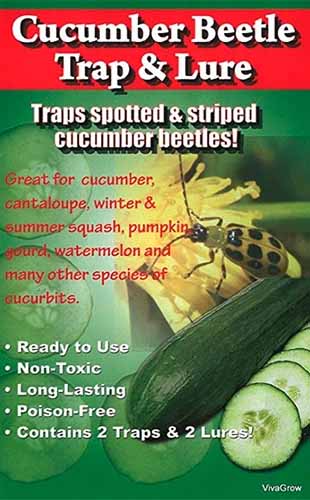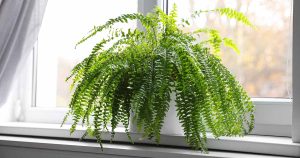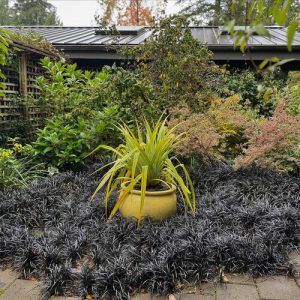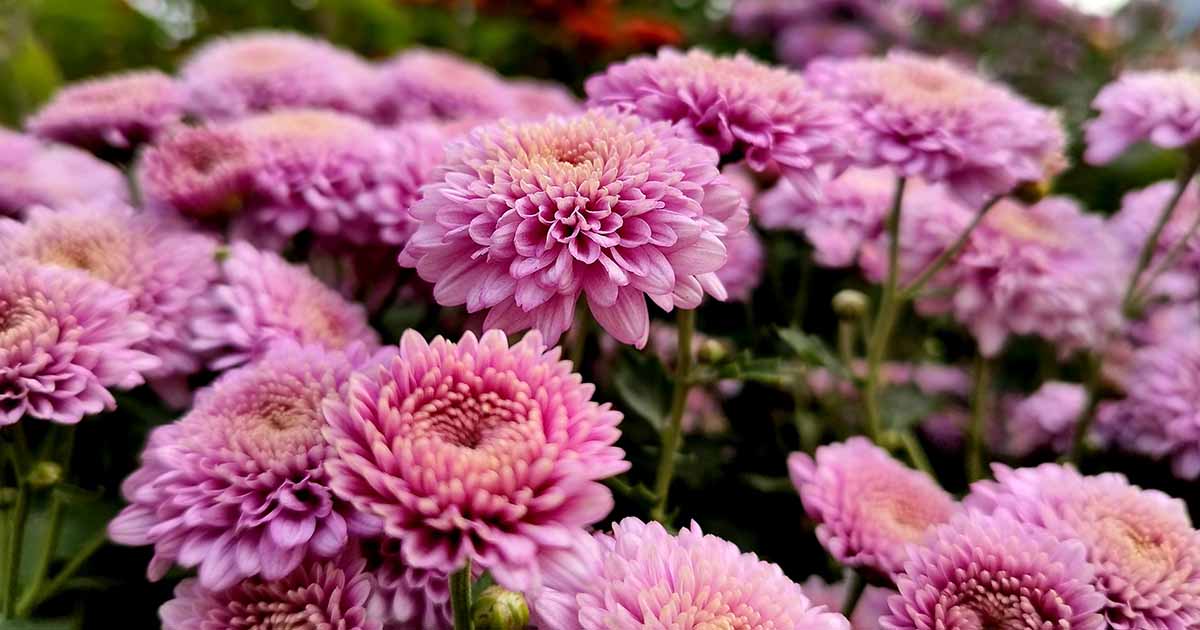
Daisy-like chrysanthemums, Chrysanthemum spp., aka mums, are herbaceous perennials. Most are suited to cultivation in USDA Hardiness Zones 5 to 9.
They prefer full sun, average two to three feet tall, and come in various colors, including green, lavender, pink, purple, red, rust, white, and yellow.
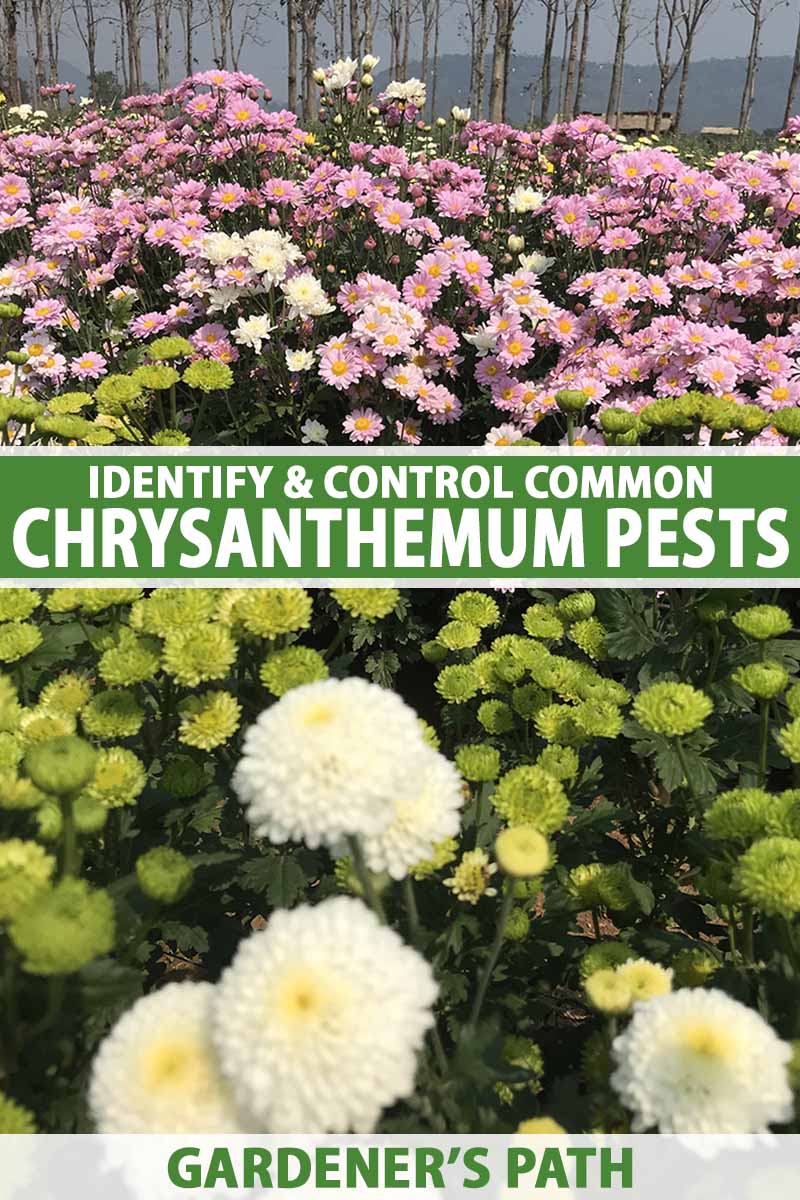
We link to vendors to help you find relevant products. If you buy from one of our links, we may earn a commission.
Our guide to growing chrysanthemums discusses cultivation in the home garden.
It is also worth noting that some types of chrysanthemums contain pyrethrins, natural insecticidal compounds that deter some pests while attracting other beneficial insects.
You can read more about the benefits of mums in the garden in our guide.
This article introduces 13 types of pests known to prey upon chrysanthemums. Read on and learn how to recognize and manage them.
Here’s our lineup:
13 Common Chrysanthemum Pests
The following undesirable insects may visit the chrysanthemums in your outdoor living space to shelter, mate, and feed their young, causing damage in the process.
Each entry highlights physical traits, likely damage, and remediation measures.
Let’s jump right in!
1. Aphids
Chrysanthemum aphids, Macrosiphoniella sanborni, are sapsucking pests that feed primarily on terminal flower buds and young foliage.
Adults are shiny and dark brown, either winged or wingless. Young nymphs are brick red and wingless.
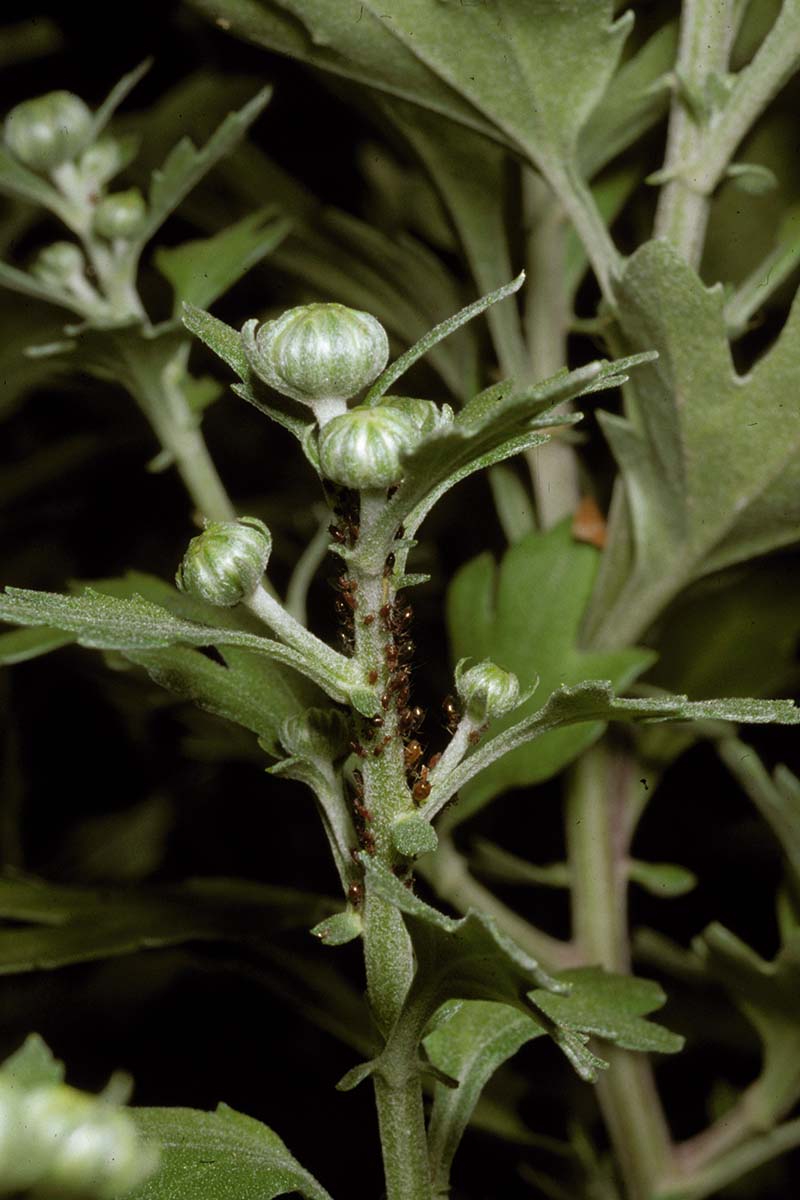
A unique feature of the species is that there are no males, and the females reproduce asexually.
They are often carriers of chrysanthemum vein mottle virus and chrysanthemum virus B, for which no curative measures exist.
The green peach aphid, Myzus persicae, melon/cotton aphid, Aphis gossypii, and root aphids, Pemphigus species, are additional species that may feed upon plants.
Aphid colors vary and include black, green, red, white, yellow.
Signs of infestation include insects stacked one upon the other, whitish flakes from shed skins, and sticky waste secretions called “honeydew.” There may also be sooty mold, as it grows readily on honeydew.
Aphids may not do enough damage to impair blooming, but large infestations can cause leaf anomalies like curling and yellowing, damaged shoots, and stunted growth.
Spray affected plants firmly with a hose to dislodge the pests or treat them with an insecticidal soap for the most negligible impact on beneficial pollinators.
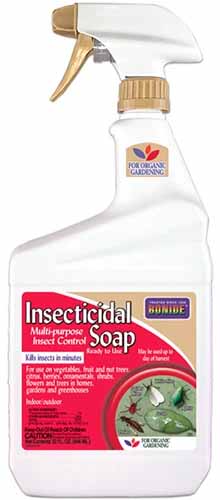
Bonide® Insecticidal Soap is available from Arbico Organics. Note that it may harm aquatic invertebrates.
This product is safe to use indoors and outdoors and comes in 12- and 32-ounce ready-to-spray bottles.
Neem oil is another organic option.
It is an effective fungicide, insecticide, and miticide. And while it’s safe for indoor and outdoor use, it may adversely affect beneficial pollinators.
Bonide® Neem Oil is available from Arbico Organics.
Choose a ready-to-use quart or gallon, or a pint of concentrate.
Please see our guide to aphids for more information on managing these pests.
2. Beetles
There are numerous types of beetles with feeding habits that damage stems, shoots, roots, leaves, flowers, and buds.

The ones most likely to adversely affect chrysanthemums are:
- Blister beetles, Epicauta spp.
- Fuller rose beetles, Pantomorus cervinus
- Rose chafers, Macrodactylus subspinosis
- Spotted cucumber beetles, Diabrotica undecimpunctata
Beetles have a hard shell and two sets of wings. The first are firm and stationary, and the second afford flight.
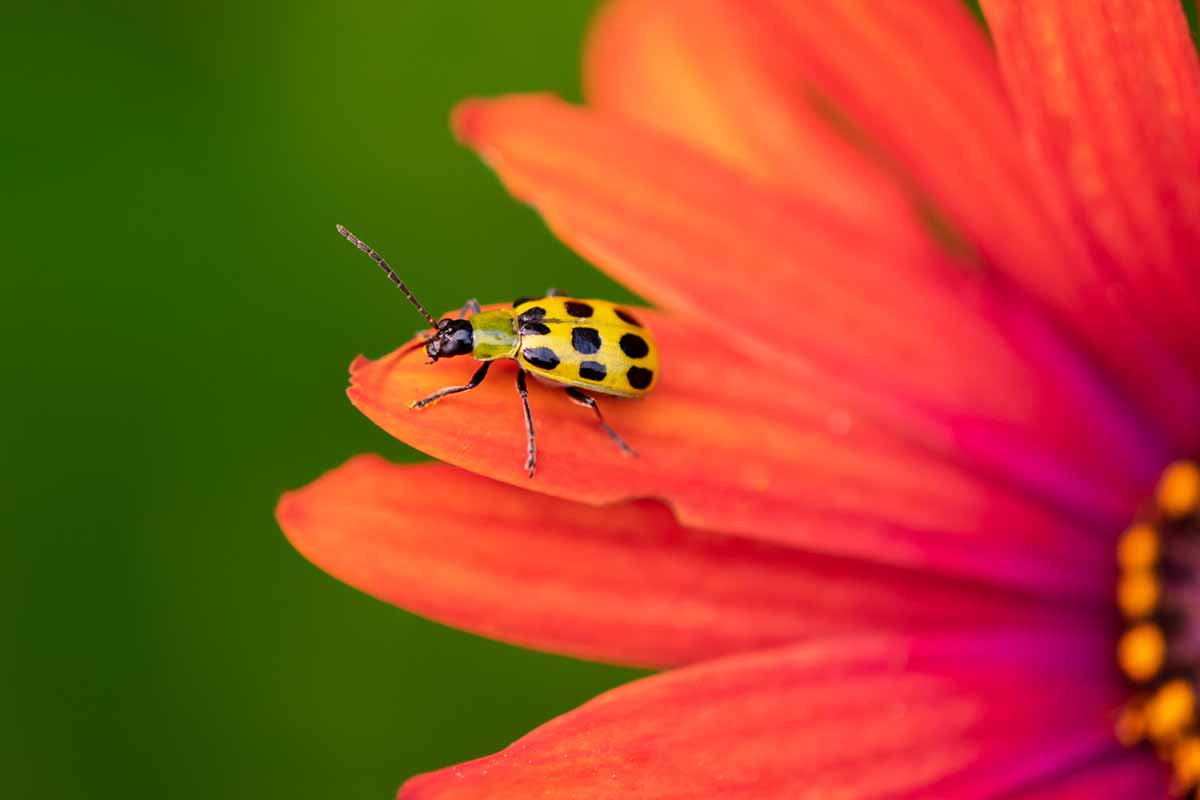
Wilting and leaves with holes chewed through them may signify the presence of unwanted beetles.
Handpicking and dropping beetles into sudsy water, and using traps and lures, are effective eradication methods when started early.
Cucumber beetle traps and lures are available from Arbico Organics.
Each package contains two traps and two lures. Ready to use, this product consists of yellow sticky traps and pheromone lures.
3. Caterpillars
Some of the same caterpillars that wreak havoc on crops may also feed upon chrysanthemums, including:
- Cabbage loopers, Trichoplusia ni
- Corn earworms, Heliothis zea
- European corn borers, Ostrinia nubilalis
- Cutworms, Noctuidae family
- Leaf rollers, Tortricidae family
Cabbage looper moths are mottled brown and the larvae are green with white stripes. They make tiny holes in leaf undersides.
Corn earworm moths are gray-brown. In the larval stage, they may be black, greenish-brown, maroon, tan, or pink, with dark stripes along their backs and yellow-spotted heads. They are known for leaving lots of “frass” or dark excrement behind when they feed on plant tissue.
European corn borer moths are yellowish-brown. The larvae are cream to gray with tiny brown circles along their bodies. Their feeding disfigures buds, flowers, and stems.
Adult cutworm moths are brown or black with black, brown, gray, or white markings.
Cutworm larvae vary widely and may be black, brown, gray, pink, or tan, glossy or smooth, and spotted or striped. A unique characteristic is that the larvae curl into a “C” shape when disturbed. They chew down new shoots or chew holes in leaves.
Adult leafroller moths are dark brown. The larvae are green or brown with black or brown heads. They roll leaves together, join them with silken threads, live inside the cavity, and feed on the foliage.
Handpick and drop the pests into sudsy water. Follow up with an application of horticultural neem oil mentioned above.
4. Foliar Nematodes
Foliar nematodes, Aphelenchoides species, are microscopic, worm-like plant parasites.
Those most likely to affect chrysanthemums are Aphelenchoides ritzema-bosi. They are hard to detect and impossible to eradicate.
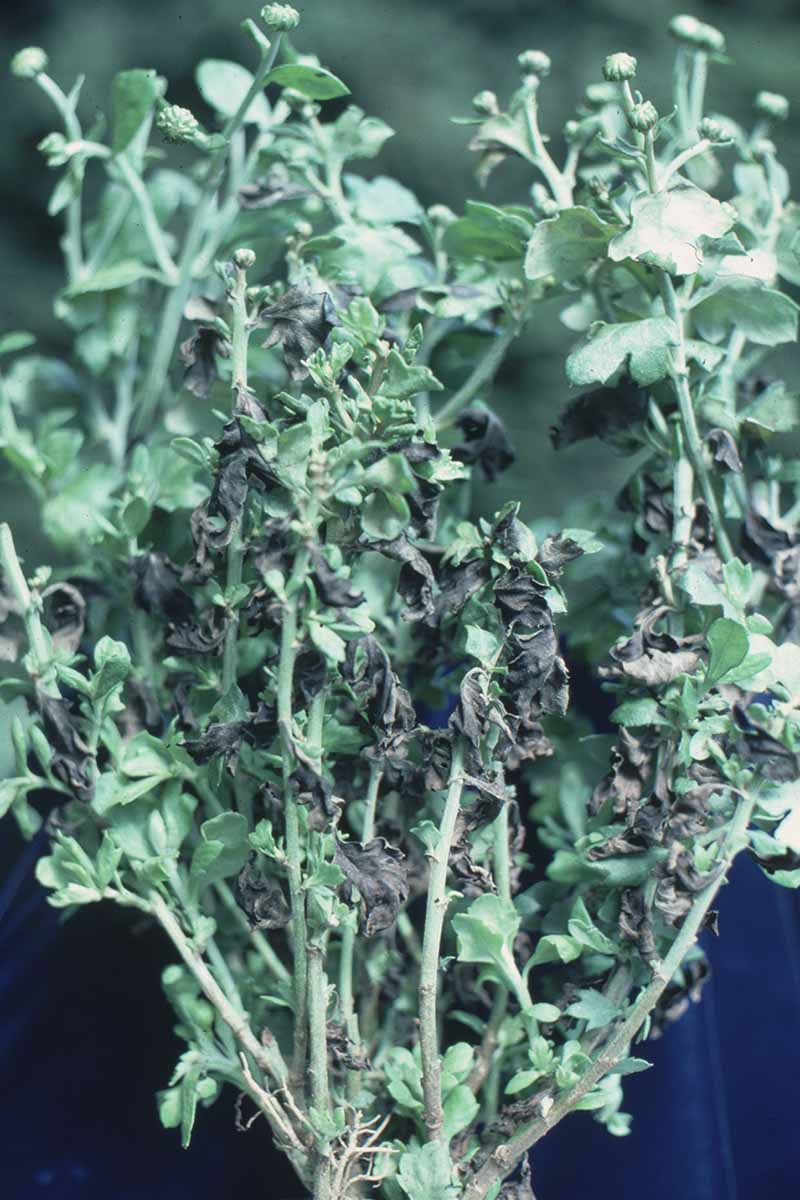
Foliar nematodes cause growth anomalies and distinct patches of brown with straight edges along leaf veins.
This affected tissue dies and falls away, leaving apparent holes behind. In advanced infestations, the damage extends beyond the foliage, and flowers fail to bloom.
Dig up and discard affected plants in the trash.
5. Fungus Gnats
Fungus gnats, Bradysia species, are more likely to affect an overly wet potted plant than one with proper drainage or those growing in the ground.
Their larvae are often present in potting soil at the time of purchase. The adults are grayish-black flies, and the larvae are white or transparent with a black head.
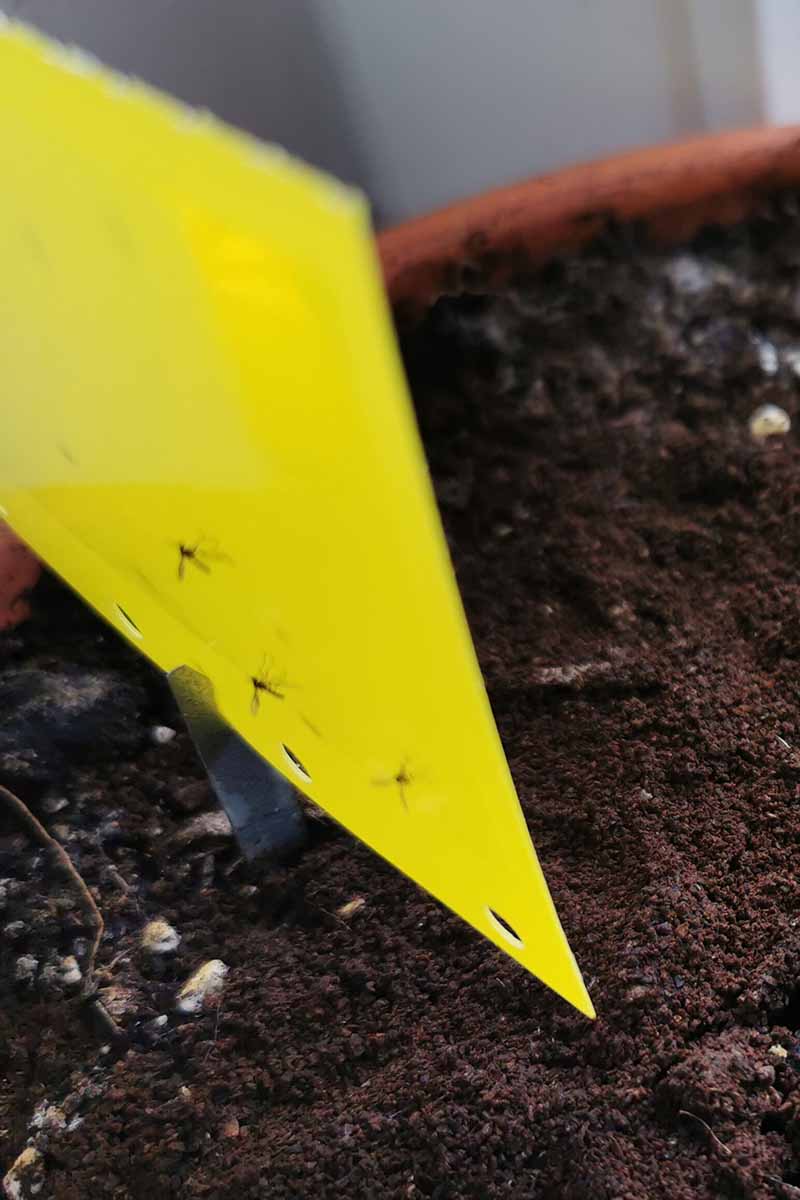
Fungus gnat larvae feed on roots and may carry pathogens that cause damping off, a disease that causes the sudden death of seedlings.
They are merely a nuisance around mature plants with well-developed root systems because the adult flies hover around affected plants.
To treat, remove and replace the top inch or two of potting soil, and sprinkle food-grade diatomaceous earth over the top. This natural pesticide is a desiccant and deterrent derived from the skeletons of aquatic organisms.
Placing yellow sticky traps near plants is also an effective way to trap adults and eradicate an infestation.
Let the potting soil dry completely before watering again to deprive the gnats of the moisture they thrive in.
Place the traps close to plants to catch flying adult fungus gnats. Note that there is a risk of catching beneficial insects, too.
Yellow insect traps are available from Arbico Organics.
Choose from packages of five, 10, 25, 50 or 100.
You’ll find more on fungus gnats in our guide.
6. Lace Bugs
Chrysanthemum lace bugs, Corythucha marmorata, are sapsucking insects with flattened, elongated, pale yellow to clear bodies.
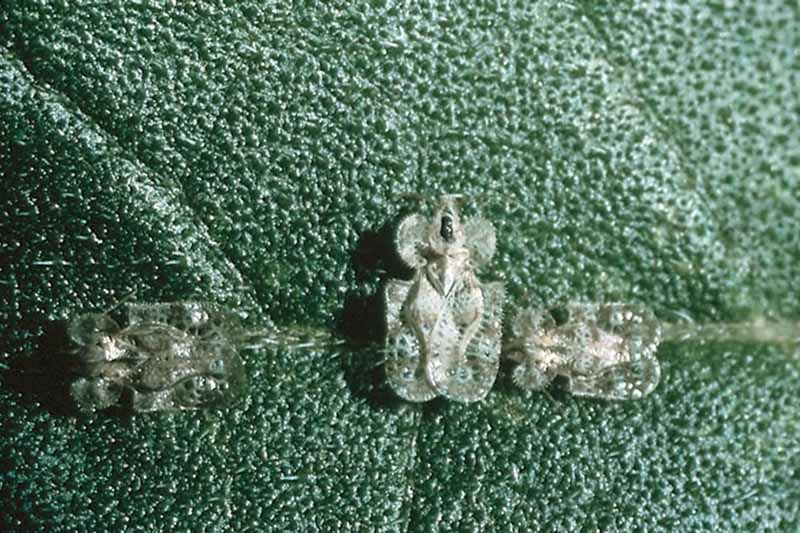
They feed voraciously on the undersides of leaves, impairing photosynthesis and leading to foliar decline.
Signs of their presence are visible on the upper sides of the leaves in the form of yellowing, and an accumulation of brown excrement and clear skin fragments.
Early insecticidal soap or horticultural neem oil treatment may thwart an all-out infestation.
Our guide to lace bugs has more details.
7. Leaf Miners
Leaf miners, chiefly the chrysanthemum leaf miner, Chromatomyia syngenesiae, as well as the American serpentine leaf miner, Liriomyza trifolii, and pea leaf miner, L. huidobrensis, are likely culprits.
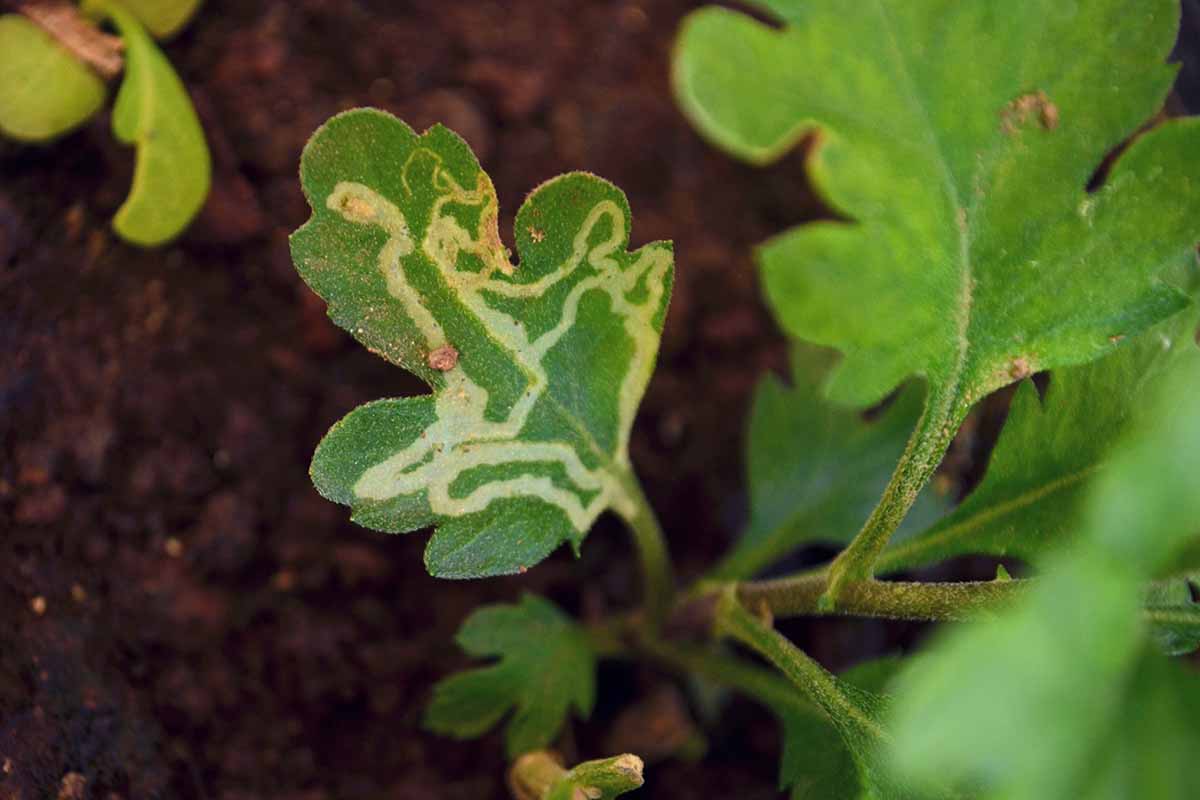
The adult chrysanthemum leaf miner is a gray to black fly. Its cream-colored larvae burrow through the foliage, leaving unsightly, whitish, winding trails.
But with any type of leaf miner infestation, the trails they leave behind are the telltale sign, rather than spotting the pests themselves.
Neem oil is an effective treatment. Products containing spinosad, a naturally derived pesticide from soil bacteria, are effective but potentially deadly to bees and other beneficial insects.
Our guide to managing leaf miners has more information.
8. Mealybugs
Mexican mealybugs, Phenacoccus gossypii, are sapsuckers that feed on plant juices, causing chrysanthemum foliage to be deformed, stunted, and wilted.
Honeydew excretions promote sooty mold proliferation.
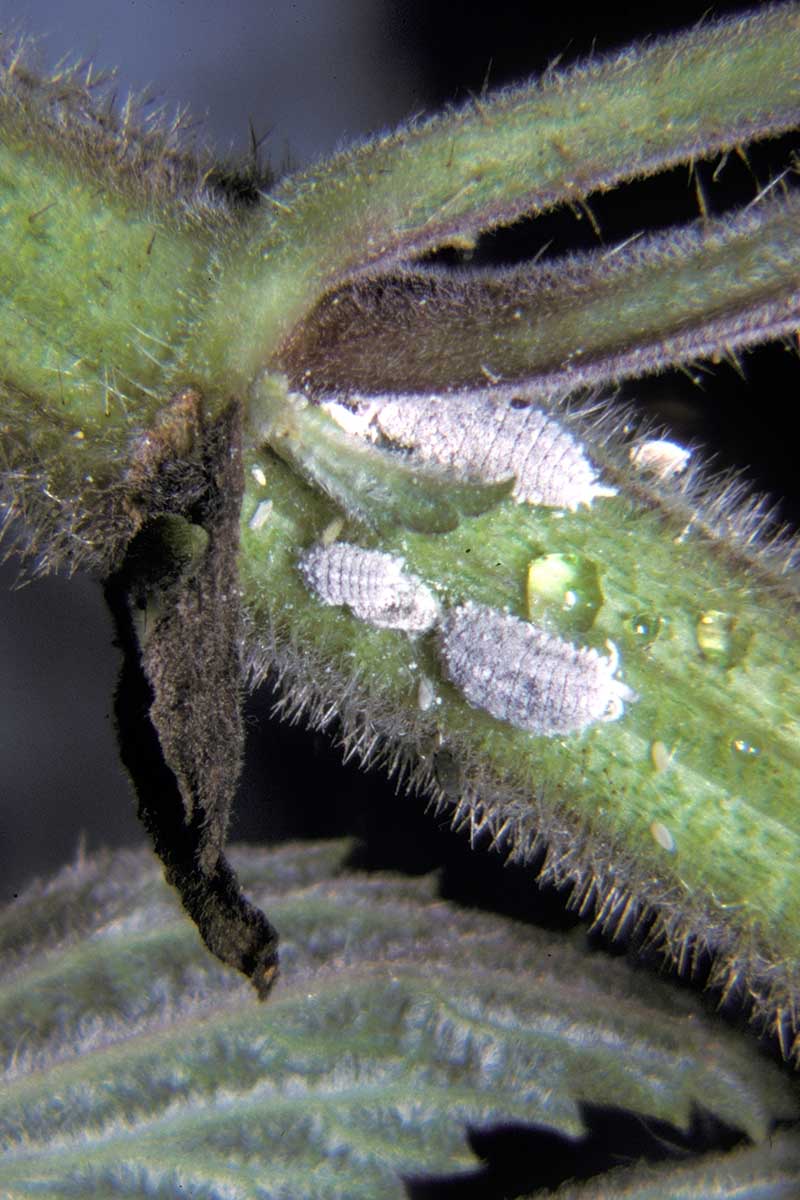
Adult females are oval, gray to white, and wooly looking. Males are tan and winged. Larvae are yellowish.
Regular treatments with insecticidal soap help to manage infestations.
See our guide to mealybugs for more information.
9. Midges
The white larvae of chrysanthemum gall midges, Rhopalomyia chrysanthemi (syn. Diarthronomyia chrysamthemi) and D. hypogaea, burrow into the foliage to feed.
Their disruption of plant tissue causes cone-like galls, leaf deformities, and stunting.
Adult flies are small, like fungus gnats, with reddish to orange-yellow bodies.
Remove affected foliage. Pesticides are ineffective.
10. Mites
If mites are a problem, they are likely cyclamen mites, Steneotarsonemus pallidus, and/or two-spotted spider mites, Tetranychus urticae, sapsuckers that feed on plant juices.
Cyclamen mites are pinkish-orange spider-like arachnids not visible to the naked eye. They stunt and wither chrysanthemum flowers and foliage.
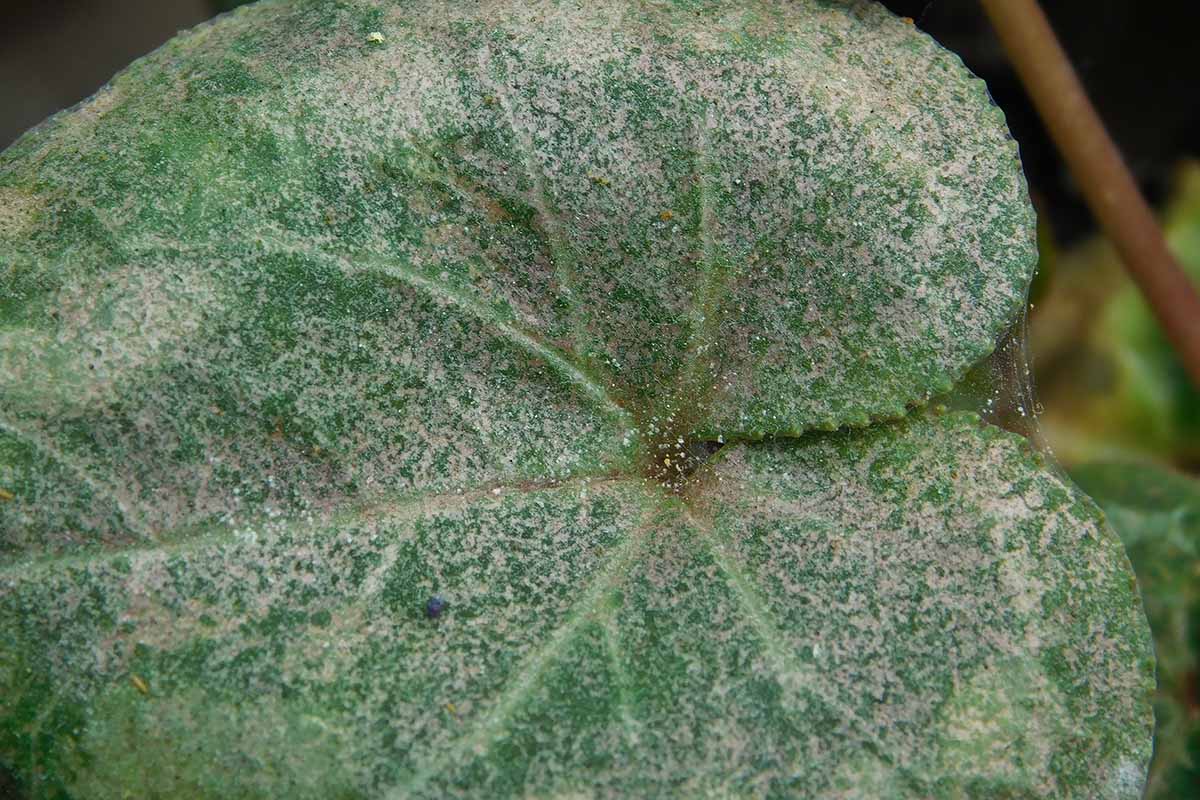
Two-spotted spider mites are nearly-microscopic spiderlike arachnids that present on the undersides of the leaves.
They look like rounded, shiny spiders and may be gray, green, or yellow, with two dark spots. Early-season females may be pink or orange.
Two-spotted spider mites cause pale dot stippling that merges and causes foliar discoloration. Leaf undersides may be web-covered.
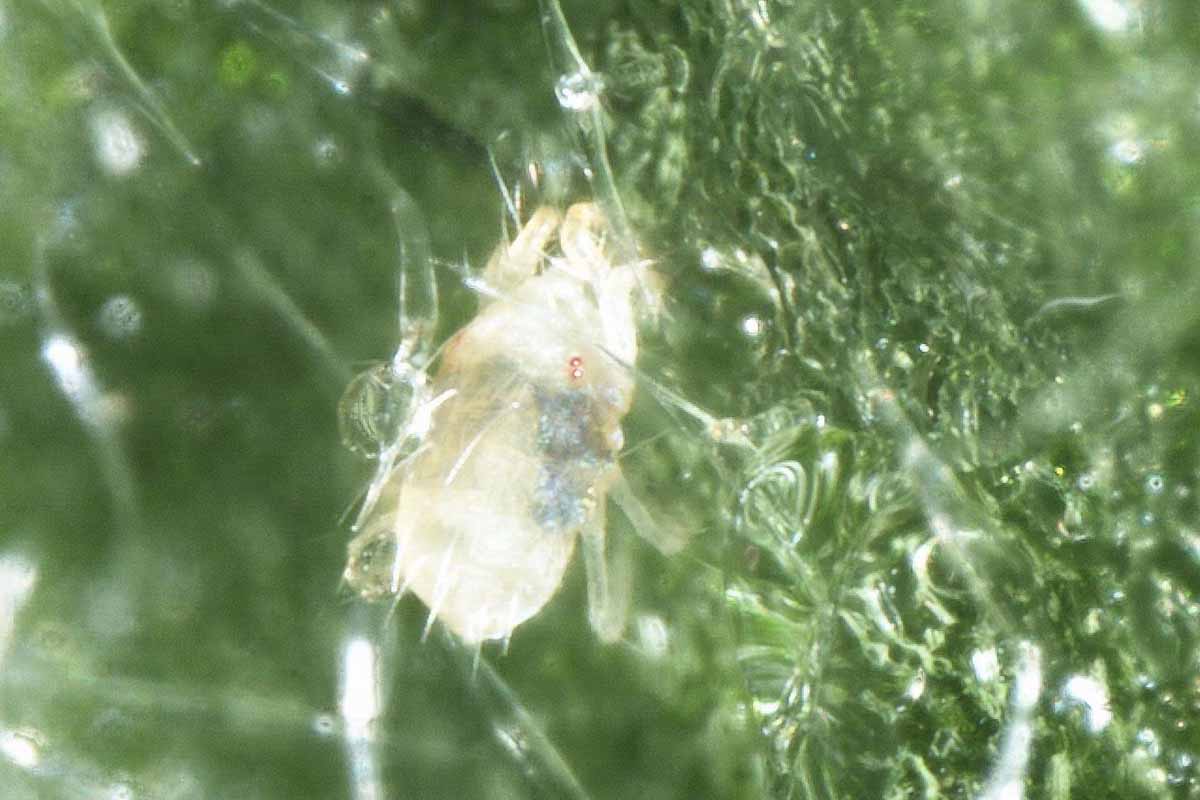
Although the mites are hard to see, their cast-off skin, excrement, and webbing make a dull, rough, readily visible coating on the chrysanthemum foliage.
Treat mites by aiming a stream of water at affected areas and follow up with applications of a miticide, like insecticidal soap or horticultural oil, as needed.
11. Thrips
Thrips are winged sapsuckers that disfigure foliage by feeding on it, causing it to appear stippled, streaked, or silvery.
Black excrement is another telltale sign of infestation. Advanced infestations can cause stunted growth.
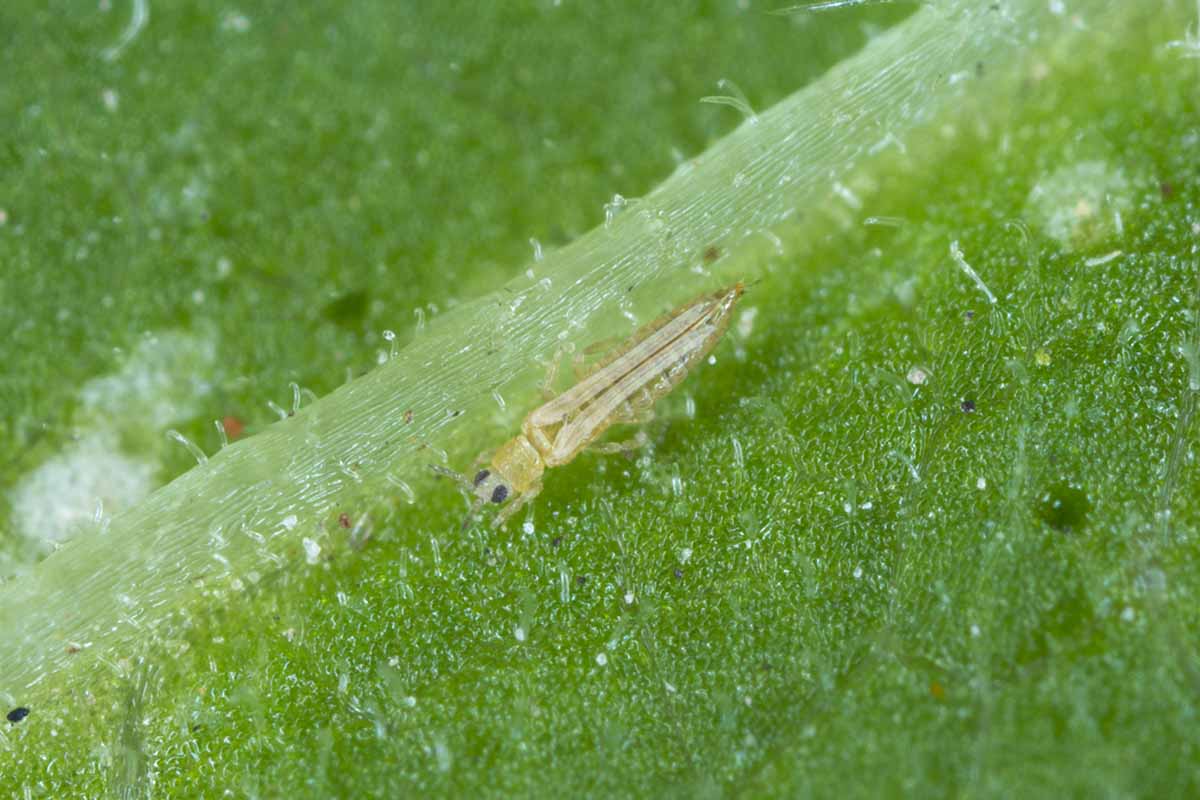
Most nymphs and adults are black, brown, white, or yellow, and some have spots, depending on the species.
Those that may pose the greatest threat are chrysanthemum thrips, Thrips nigropilosus, and greenhouse thrips, Heliothrips haemorrhoidalis.
A strong spray with the hose, followed by applications of horticultural oil, may be all you need to combat these pests.
See our guide to thrips for detailed management information.
12. Other True Bugs
Heteroptera, aka the “true bugs,” is a suborder of insects with specific characteristics, including sucking mouthparts to consume plant or animal tissue, a hardened head underside called a “gula,” and overlapping forewings.
They may jump or fly, and their colors vary widely.
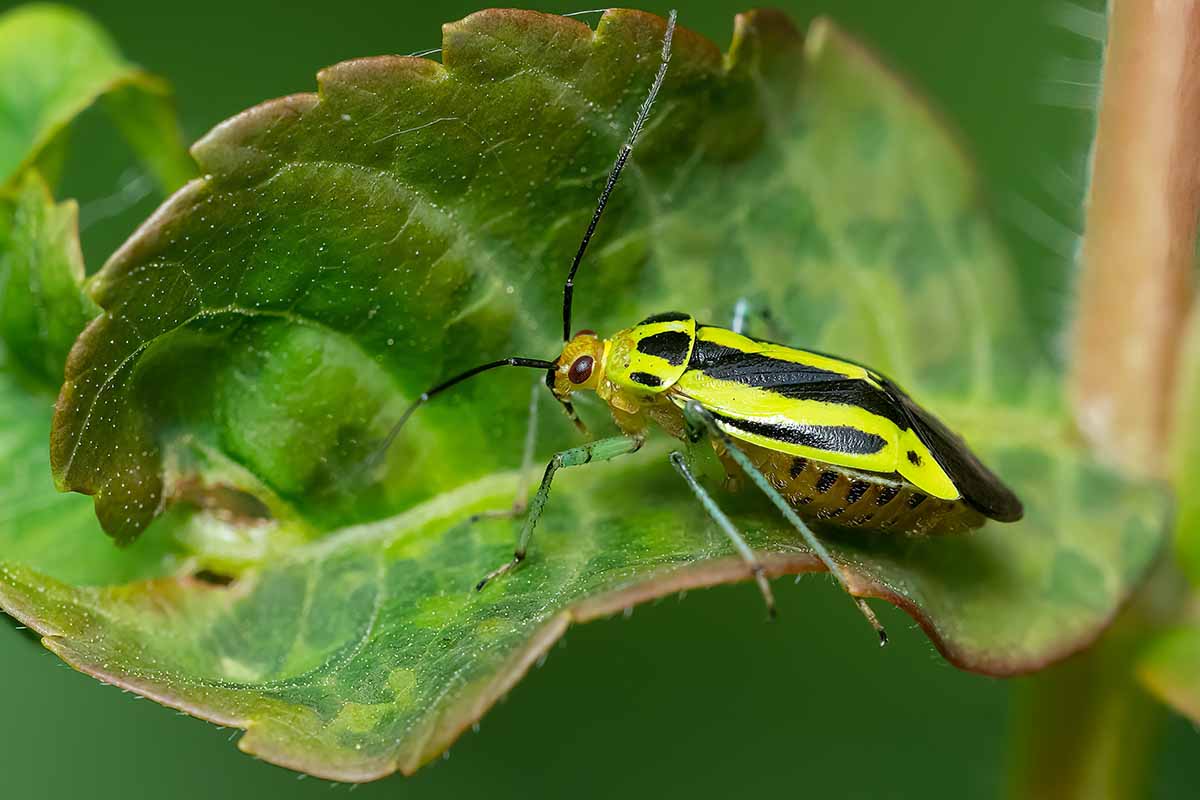
Heteroptera is a unique suborder within the larger Hemiptera order of true bugs. However, not all true bugs within the broader order have mouthparts used to suck animal or plant tissue and a hardened head underside.
The Hemiptera order includes cicadas and grasshoppers, as well as several other pests also described here – aphids and whiteflies as well as lace bugs, the latter of which also belong to the Heteroptera suborder.
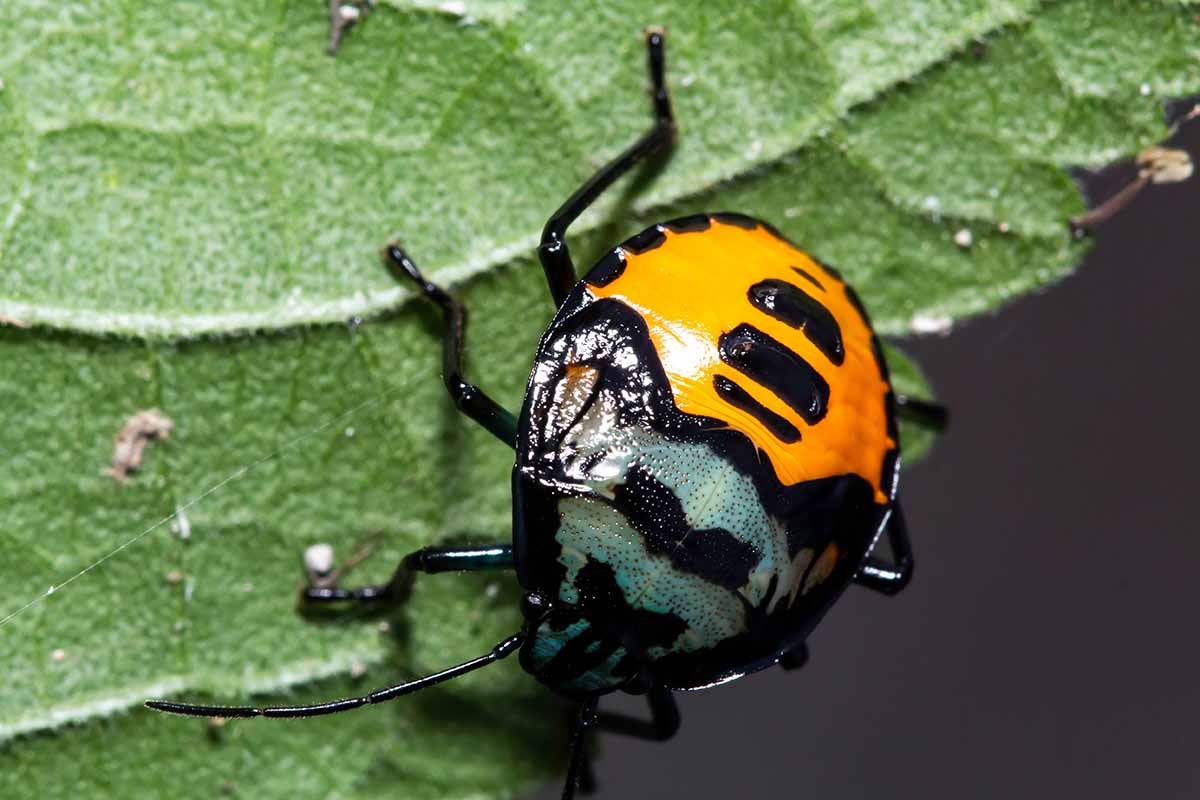
Additional Heteroptera true bugs not described elsewhere in this guide that are most likely to affect chrysanthemums are:
- Four-lined plant bugs, Poecilocapsus lineatus
- Harlequin bugs, Murgantia histrionica
- Meadow spittlebugs, aka meadow froghoppers, Philaenus spumarius
- Tarnished plant bugs, Lygus lineolaris
These insects suck juices from foliage, leaving it discolored, stippled, and covered in excrement.

Spittlebugs have a unique characteristic: they excrete a bubbly, spit-like waste, making them easy to identify.

Damage caused to chrysanthemums by these pests is unsightly rather than deadly, and insecticidal soap or horticultural oil is usually all you need to treat affected plants.
13. Whiteflies
Whiteflies are milky-white sapsucking flies that don’t fly long distances but rather rise into the air en masse when startled, like a puff of powder.
They hatch on the undersides of leaves, where they begin to feed and leave honeydew behind, rendering plants vulnerable to sooty mold.
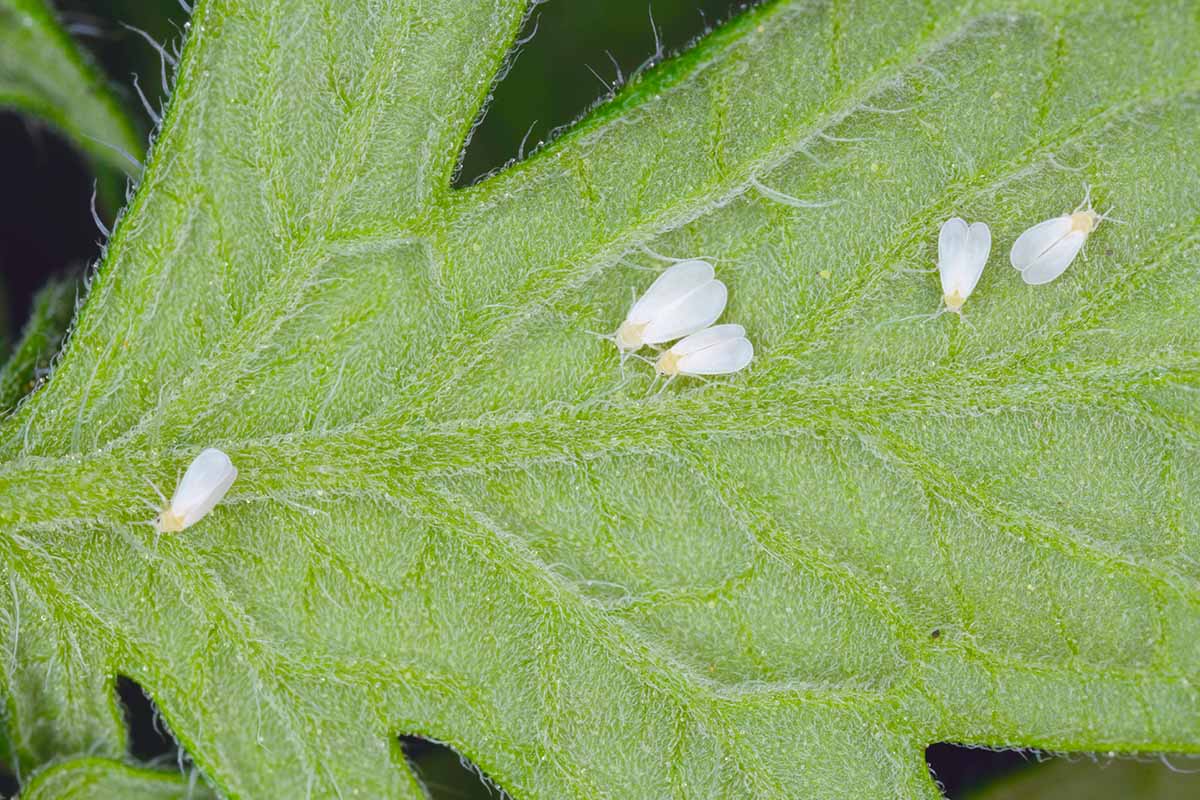
Those most likely to affect chrysanthemums are greenhouse whiteflies, Trialeurodes vaproariorum.
They may be present on plants at the time of purchase if they have been grown in an infested greenhouse.
Whitefly feeding damages foliage, turning it yellow and stunting growth. New leaves are most susceptible.
Use a firm hose spray to wash them off foliage and follow up within applications of insecticidal soap as needed.
See our guide to whiteflies for more information.
Magnificent Mums
Now that you’re familiar with 13 types of pests, you’re ready to inspect your plants daily and take quick action if you detect their presence.
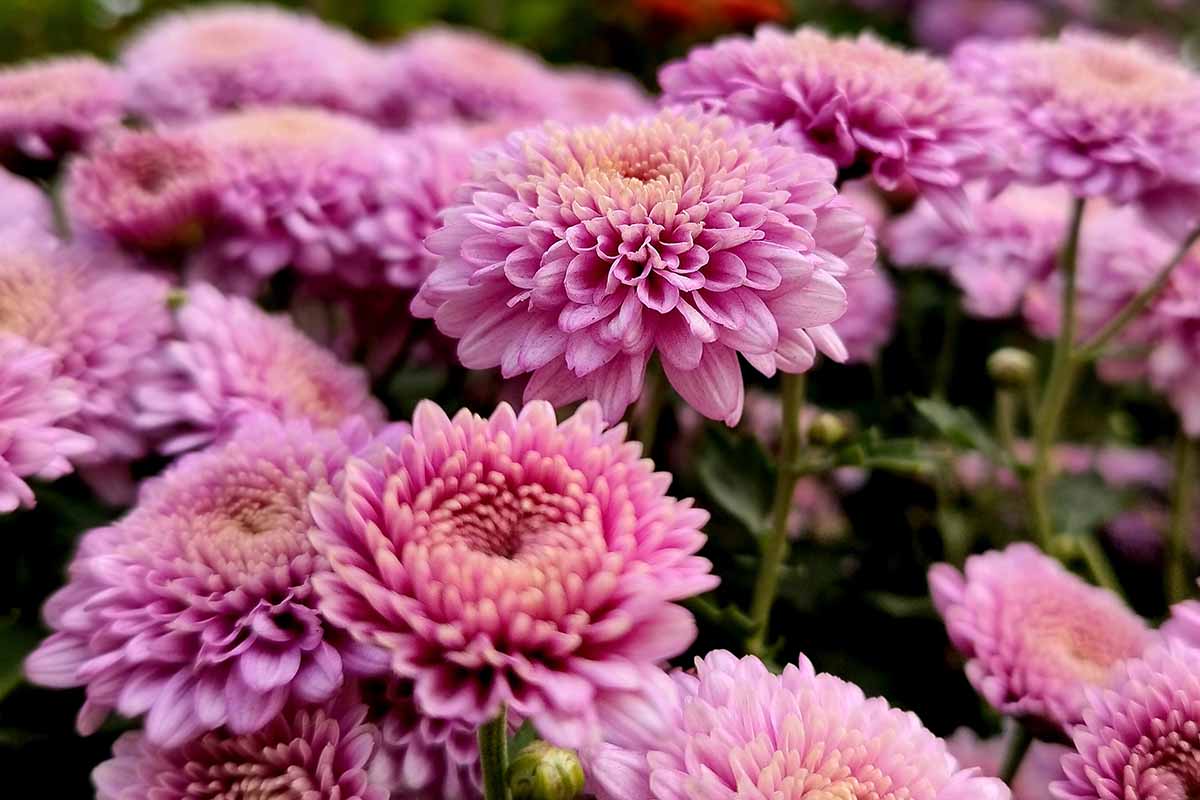
It may be helpful to have a magnifying glass to examine foliage and the insects that visit it to avoid inadvertent harm to beneficial pollinators.
If you remove pest-damaged flora, remember to dispose of it in the trash rather than the compost heap.
At season’s end, prune the dried stems down to a height of three inches above the crown, where the stems and roots meet. Clear the debris to avoid harboring destructive pests and pathogens.
With vigilant pest management, chrysanthemums provide a magnificent late-season display.
How are your mums this year? Have you had to treat them? Please share your experience in the comments section below.
If you found this article informative and want to read more about chrysanthemum care, we recommend the following:

